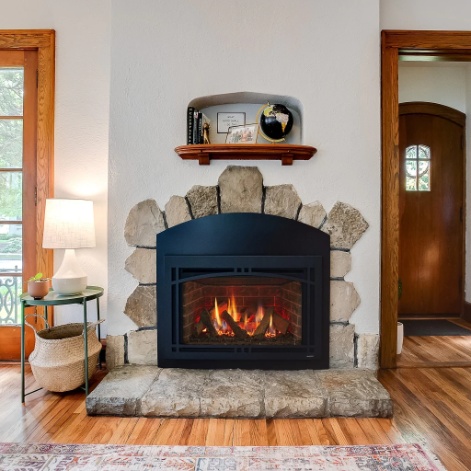Table of Contents
- 1 What Is Seasoning Firewood?
- 2 Why Is It Important To Season Firewood?
- 3 What Are The Factors That Affect The Seasoning Time Of Firewood?
- 4 What Are The Fastest Types Of Firewood To Season?
- 5 What Are The Slowest Types Of Firewood To Season?
- 6 How To Speed Up The Seasoning Process?
- 7 Frequently Asked Questions
Are you someone who enjoys cozy nights by the fire during the colder months? If so, you likely know the importance of properly seasoned firewood.
In this article, we will discuss what seasoning firewood is and why it is important.
We will also cover the various factors that can affect the seasoning time of different types of wood.
Let’s explore the fastest types of firewood to season, as well as the slowest types.
Discover how you can speed up the seasoning process and ensure you have a plentiful supply of well-seasoned firewood for your next gathering.
What Is Seasoning Firewood?
Seasoning firewood is the process of drying freshly cut wood to reduce its moisture content and improve its burning efficiency.
This method is crucial because burning wood with high moisture levels can create excessive smoke.
It can also reduce heat output and lead to a buildup of creosote in the chimney.
To effectively season firewood, it is important to allow air circulation around the wood piles.
Stacking the logs in a crisscross pattern helps with this.
For indoor storage, a well-ventilated area like a woodshed can help accelerate the drying process.
Outdoor storage should involve stacking the wood off the ground on pallets or other supports to prevent moisture absorption from the soil.
Why Is It Important To Season Firewood?
Seasoning firewood is crucial to ensure optimal burning efficiency, heat output, and energy savings.
It also reduces smoke and increases the quality of the fire.
Properly seasoned firewood has lower moisture content, which allows it to ignite more easily and burn more efficiently.
This results in a cleaner burn with reduced smoke emissions.
It makes it not only environmentally friendly but also healthier for those inhaling the air around the fire.
The drying process also contributes to improved heat output.
The energy is not wasted evaporating excess moisture but is instead utilized for producing warmth.
Therefore, taking the time to season firewood properly can significantly impact the overall quality of your fire and enhance your burning experience.
What Are The Factors That Affect The Seasoning Time Of Firewood?
Various factors influence the time required to season firewood.
These include the type of wood, moisture content, size, shape, climate, and drying methods such as air-drying or kiln-drying.
- The type of wood plays a crucial role in how quickly firewood can be seasoned. Hardwoods like oak or maple typically take longer to season compared to softwoods such as pine or spruce.
- The moisture content of the wood also affects the speed of seasoning, with wetter wood requiring more time. The environmental conditions, such as humidity and temperature, impact the drying process.
- Factors like wind exposure can accelerate air-drying, while a consistent climate is beneficial for kiln-drying methods.
Type Of Wood
The type of wood used for firewood significantly impacts the seasoning process.
Hardwoods like ash, oak, and maple season more efficiently than softwoods such as pine, spruce, and cedar.
Hardwoods like ash and beech are known for their dense structure.
This allows them to dry out more slowly but thoroughly during seasoning, resulting in higher quality firewood.
On the other hand, softwoods like pine and cedar typically have a higher moisture content and resin levels.
This makes them quicker to dry but also more prone to burning too fast.
Maple, another hardwood option, falls in between ash and beech in terms of seasoning time.
It offers a good balance between efficiency and quality.
Moisture Content
The moisture content of firewood is a critical factor in seasoning time.
Wet wood requires a longer drying process compared to drier logs, necessitating proper storing techniques for optimal results.
When firewood has a high moisture content, it takes more time to dry.
It also leads to inefficient burning, excess smoke, and reduced heat output.
To manage wet wood effectively, one can employ simple tips.
Stack logs in a way that promotes airflow, store them in a dry, elevated area, and cover the pile with a tarp to shield it from rain or snow.
Ensuring the wood is adequately seasoned is essential for efficient and clean-burning fires.
This makes it crucial to prioritize dryness in the storing process.
Size And Shape Of Wood
The size and shape of firewood pieces play a role in the seasoning process.
Well-split logs dry more efficiently and uniformly, influenced by log size and stacking techniques.
When it comes to splitting logs for optimal seasoning, it’s crucial to consider the size and shape to enhance drying.
Smaller wood pieces tend to dry faster than larger ones due to their increased surface area exposed to air.
This aids in reducing moisture content and promotes efficient drying.
The shape of the logs also impacts the drying process.
For instance, round logs may dry more slowly than those that are split into smaller sections.
Factors such as air circulation, sunlight exposure, and proper stacking methods further contribute to the effectiveness of the seasoning process.
Climate And Weather
The climate and weather conditions, especially during winter, have a direct impact on the speed of firewood seasoning.
This influences the choice between outdoor and indoor drying methods for fireplace or stove use.
Harsh winter conditions with heavy snowfall and low temperatures can significantly slow down the seasoning process of firewood when left outdoors.
In such scenarios, opting for indoor drying methods, like using a well-ventilated area or a woodshed, can help maintain a more controlled environment for quicker drying.
Outdoor drying under the right weather conditions can also be advantageous.
It allows for natural air circulation and exposure to sunlight, accelerating the seasoning process without the need for additional heating sources commonly used indoors.
What Are The Fastest Types Of Firewood To Season?
Some of the fastest types of firewood to season include hardwoods like ash, oak, and maple, as well as softwoods such as pine, spruce, and cedar.
These are known for their quick drying and efficient seasoning properties.
Hardwoods like oak and maple are particularly prized for their efficiency in burning and long-lasting heat output.
Oak, for instance, has a dense composition that allows it to burn slower and produce high heat levels.
This makes it ideal for heating larger spaces.
Maple is known for its pleasant aroma when burned.
On the other hand, softwoods like pine and cedar are quick to ignite but may burn faster than hardwoods.
Some quick-drying options to consider are cherry or ash, which can be seasoned in a relatively short amount of time.
Softwoods (Pine, Spruce, Cedar)
Softwoods such as pine, spruce, and cedar are among the fastest types of firewood to season.
They have quick drying properties, making them suitable for efficient seasoning using various indoor and outdoor techniques.
These fast-seasoning softwoods are characterized by their lightweight nature and high resin content.
This aids in the quick evaporation of moisture during the drying process.
To ensure effective seasoning, it is essential to employ proper drying techniques.
Splitting the wood into small pieces facilitates airflow and utilizing well-ventilated storage areas.
By following these efficient methods, softwoods can be seasoned in a relatively short period.
This results in high-quality seasoned firewood ready for use.
Hardwoods (Oak, Maple, Ash)
Hardwoods including oak, maple, and ash are known to season quickly and efficiently.
They benefit from factors like speed drying, kiln techniques, and proper stacking and storing methods.
This rapid seasoning process of hardwoods plays a crucial role in maintaining the quality of the wood.
It also prevents issues such as warping or cracking.
Efficient drying factors, such as controlling humidity levels and air circulation, are essential.
They ensure that the wood dries uniformly without compromising its structural integrity.
Kiln techniques further aid in speeding up the drying process while maintaining consistent quality.
Proper stacking and storing practices are also vital to prevent moisture reabsorption.
This ensures that the wood remains in optimal condition for use in various applications.
Exotic Woods (Birch, Beech, Cherry)
Exotic woods like birch, beech, and cherry offer quick seasoning properties.
They are popular choices for firewood due to their efficient drying process and high-quality results.
These woods are renowned for their unique seasoning characteristics.
They often impart a distinct aroma and flavor when used for smoking meats or adding flavor to grilled dishes.
Their quick seasoning process allows for a faster turnaround time from cutting to usage.
This ensures that the wood is ready to deliver optimal performance in fireplaces, grills, or smokers.
Whether enhancing the ambiance of indoor spaces with a cozy fire or elevating the outdoor cooking experience with aromatic wood smoke, these exotic woods consistently deliver exceptional quality.
What Are The Slowest Types Of Firewood To Season?
Dense hardwoods such as hickory, ironwood, and osage orange are among the slowest types of firewood to season.
Wet or green wood also requires extended drying periods.
These dense hardwoods are prized for their high energy content.
This makes them ideal for long-burning fires that provide steady heat.
Hickory, in particular, is known for its pleasant aroma and clean burn.
On the other hand, ironwood poses a challenge due to its extremely dense nature.
This requires even more time to dry properly.
Using wet or green wood can result in excessive smoke, reduced heat output, and increased creosote buildup in the chimney.
This leads to potential safety hazards.
It’s crucial to allow ample time for all firewood types to season properly before use.
Dense Hardwoods (Hickory, Ironwood, Osage Orange)
Dense hardwoods such as hickory, ironwood, and osage orange present challenges in seasoning.
They require special care in splitting, stacking, and storing for optimal results.
These dense hardwoods are known for their tightly packed fibers.
This makes them particularly difficult to season properly.
The slow drying process is crucial to prevent warping and cracking.
It ensures the wood is seasoned evenly throughout.
When it comes to splitting, making sure to create small, manageable pieces will aid in expediting the drying process.
Proper stacking techniques involve allowing for adequate airflow between the wood pieces.
This prevents moisture build-up, which can lead to mold or decay.
Choosing a dry and well-ventilated area for storage is essential.
This helps maintain the quality of the split wood over time.
Wet Or Green Wood
Wet or green wood poses challenges in the seasoning process.
Their high moisture content leads to extended drying times.
This requires air-drying or kiln techniques for efficient seasoning.
When dealing with wet or green wood, the prolonged drying periods can be quite frustrating.
Air-drying, though a traditional method, often requires more time compared to kiln drying.
Kiln drying, on the other hand, offers a more controlled environment.
This allows for quicker and more efficient drying.
The time saved with kiln drying can be significant.
This is especially true for commercial purposes where efficiency plays a crucial role in the production timeline.
How To Speed Up The Seasoning Process?
To accelerate the seasoning process of firewood, efficient techniques like proper splitting, stacking, moisture control, using a moisture meter, and utilizing a firewood kiln can significantly reduce drying time.
When it comes to splitting and stacking firewood, the key is to ensure that the pieces are of uniform size.
This aids in consistent drying.
Stacking the firewood off the ground on a raised platform can help improve airflow.
This prevents moisture absorption from the soil.
Managing the moisture content is crucial.
Wet firewood not only burns poorly but also creates more smoke.
By checking the wood’s moisture levels with a moisture meter regularly, you can gauge when it’s ready for use.
Kiln-drying offers a more controlled environment.
This decreases the overall drying time while maintaining the wood’s quality and reducing the risk of mold growth.
Splitting The Wood
Splitting firewood into smaller pieces enhances the seasoning process.
It increases surface area exposure to air, improving drying efficiency.
This facilitates both indoor and outdoor storage.
This increased air exposure allows for faster moisture evaporation from the wood.
It ultimately leads to a more efficient drying process.
By utilizing proper techniques such as using a sharp axe or a maul and following the wood’s natural grain, wood can be split effectively.
For indoor storage, stacked split wood in a well-ventilated area can prevent mold growth.
Outdoor storage benefits from keeping the split wood off the ground to avoid moisture seepage and decay.
Stacking The Wood Properly
Properly stacking firewood ensures adequate airflow, uniform drying, and space optimization.
These are essential elements that speed up the seasoning process and enhance overall efficiency.
This structured approach to stacking logs also helps prevent mold and rot.
It allows moisture to escape easily, thereby maintaining the quality of the firewood.
By ensuring proper airflow through the stacked wood, you create optimal conditions for the drying process.
This is crucial for achieving consistent and effective seasoning.
Proper stacking helps in maximizing the use of available space, whether in a woodshed or outdoor storage area.
This results in better organization and management of your firewood inventory.
Providing Adequate Airflow
Ensuring sufficient airflow around stacked firewood promotes faster drying.
It reduces moisture content and improves overall efficiency in both indoor and outdoor storage setups.
This is crucial for optimal seasoning.
This consistent airflow aids in the process of moisture reduction.
It is essential for preventing mold growth and decay in firewood.
Kiln-dried firewood, in particular, benefits from controlled airflow.
This accelerates the drying process and results in wood with lower moisture levels.
Efficient kiln operations depend greatly on proper airflow management.
This ensures that the wood is dried evenly and thoroughly.
Without adequate airflow, the seasoning process can be hindered.
This leads to unevenly dried firewood and potential quality issues.
Using A Moisture Meter
Employing a moisture meter for firewood allows precise monitoring of moisture levels.
This facilitates informed decisions on the drying process, efficiency enhancements, and proper kiln, stacking, and storing practices.
This tool is indispensable for anyone involved in firewood preparation.
It helps in determining the optimal moisture content for efficient burning and reducing pollutants.
By continually monitoring the moisture levels, you can avoid over- or under-drying the wood.
This ensures it is ready for use when needed.
Proper utilization of the meter can lead to significant time and cost savings.
It prevents wastage and improves overall firewood quality.
Implementing the readings from the moisture meter also aids in preventing potential hazards.
This includes chimney fires caused by excessive moisture content in the wood.
Using A Firewood Kiln
Utilizing a firewood kiln accelerates the seasoning process.
It provides controlled drying conditions, ensuring fast and efficient wood preparation.
This is suitable for both indoor and outdoor storage, enhancing firewood quality.
By using a firewood kiln, the moisture content in the wood is carefully regulated.
This prevents issues such as mold or decay that can occur with air-drying methods.
The controlled environment of a kiln also reduces the chances of warping or cracking in the wood.
This results in a higher-quality product for burning.
With proper monitoring and management, a firewood kiln allows for quicker turnaround times.
This makes it a practical choice for those looking to maintain a consistent supply of seasoned firewood throughout the year.
Frequently Asked Questions
1. What is seasoning firewood?
Seasoning firewood is the process of drying freshly cut wood to reduce its moisture content, improve burning efficiency, and minimize smoke emissions.
2. Why is it important to season firewood?
Properly seasoning firewood ensures optimal burning efficiency, enhances heat output, reduces smoke, and leads to a cleaner burn, making fires more environmentally friendly.
3. What factors affect the seasoning time of firewood?
Factors include the type of wood, moisture content, size and shape of logs, climate, and drying methods such as air-drying and kiln-drying.
4. What are the fastest types of firewood to season?
Softwoods like pine and spruce, and hardwoods such as ash and maple are among the fastest types of firewood to season due to their quick drying properties.
5. What are the slowest types of firewood to season?
Dense hardwoods like hickory, ironwood, and osage orange are among the slowest to season due to their tightly packed fibers requiring more time to dry properly.
6. How can I speed up the seasoning process of firewood?
You can speed up seasoning by properly splitting the wood, stacking it in a way that promotes airflow, monitoring moisture levels with a moisture meter, and using a firewood kiln.
7. Does the size and shape of wood affect seasoning?
Yes, smaller, well-split logs dry more efficiently due to increased surface area exposed to air, which aids in quicker moisture evaporation.
8. Can the climate and weather affect how quickly firewood seasons?
Yes, harsh winter conditions can slow down the seasoning process, while warm, dry climates can enhance drying speed, making outdoor seasoning more effective during appropriate weather.
9. What are the consequences of burning unseasoned wood?
Burning unseasoned wood can result in excessive smoke, decreased heat output, and increased creosote buildup, which poses safety hazards in chimneys.
10. How important is airflow in the wood drying process?
Airflow is crucial for the wood drying process as it helps reduce moisture content and prevents mold and decay, leading to more efficient seasoning.
Latest Articles

What Is An NG (Natural Gas) Indicator And Why You Need It For Your Fireplace
Table of Contents1 Understanding Natural Gas Fireplaces2 What is an NG Indicator?3 Importance of NG Indicators for Safety4 Types of NG Indicators5 Installation and Maintenance of NG Indicators6 Signs of a Faulty NG Indicator7 Frequently Asked Questions Natural gas fireplaces are a favored option among numerous homeowners due to their convenience and effectiveness. But, what is an NG (Natural Gas) indicator and why you need it for your fireplace? It is imperative to comprehend how they function and the significance of having an NG (Natural Gas) indicator for safety purposes. This article delves into the definition and significance of NG indicators. We will discuss the potential hazards associated with the absence of one and the various types of indicators accessible. Also, we will discuss installation and maintenance recommendations, and methods to recognize and rectify issues with malfunctioning indicators. Stay well-informed and ensure the safety of your home by referring to this exhaustive guide. Understanding Natural Gas Fireplaces Natural gas fireplaces serve as an efficient and convenient heating option for numerous households. They utilize natural gas as a fuel source to deliver consistent warmth and ambiance. How They Work and Why They Need NG Indicators The operation of natural gas fireplaces involves igniting natural gas to generate heat. This process requires diligent monitoring to ensure both safety and efficiency, a task facilitated by the use of NG indicators. NG indicators play a critical role in detecting potential gas leaks. They enable residents to promptly address and mitigate any associated hazards. Through continuous monitoring of gas levels and providing timely warnings and alerts, NG indicators uphold a secure indoor environment. It is imperative to ensure that these indicators function properly to facilitate the effective operation of natural gas fireplaces. This helps mitigate the inherent risks linked to gas leaks. What is an NG Indicator? An NG indicator is a specialized device equipped with advanced sensors and technology. It is specifically designed to detect natural gas leaks and monitor gas pressure in appliances, such as fireplaces. Definition and Purpose The NG indicator functions as a detector that monitors gas appliances for potential leaks. It provides essential functionality to ensure safety in households utilizing natural gas. These detectors play a crucial role in protecting residences by notifying occupants of dangerous gas leaks long before they escalate into perilous situations. Through continuous monitoring of gas levels in the vicinity, NG indicators offer an additional layer of protection. This is particularly important in properties that rely on gas-operated fireplaces or stoves. These devices not only help avert potential disasters but also enhance the overall peace of mind of homeowners. They assure them that their living spaces are equipped with reliable safety features. Importance of NG Indicators for Safety Natural gas indicators are essential for maintaining safety in households equipped with natural gas appliances. These devices serve as a proactive measure to promptly detect gas leaks. This offers homeowners a sense of security and assurance. Potential Dangers of Not Having an NG Indicator The absence of an NG indicator in residences equipped with natural gas appliances can pose significant hazards. This includes the risk of undetected gas leaks , carbon monoxide poisoning , and pilot outages that may lead to dangerous situations. These potential risks can profoundly impact indoor air quality. They directly influence the health and safety of individuals residing in the household. Undetected gas leaks can go unnoticed, gradually permeating the air and creating a potentially explosive environment. Insufficient ventilation from undetected exposure to carbon monoxide can lead to serious health complications. These range from mild symptoms such as dizziness to fatal poisoning. Without proper monitoring from an NG indicator, families are left susceptible to these concealed threats. This underscores the critical importance of implementing proactive measures to mitigate such risks. Types of NG Indicators Indicators for Natural Gas (NG) are available in diverse types. Each presents distinct detection capabilities tailored to specific requirements, encompassing both manual and automated alternatives. Manual vs. Automatic Indicators Manual NG indicators require user intervention for monitoring gas levels and identifying leaks. On the other hand, automatic indicators employ sophisticated technology to deliver continuous, real-time monitoring. This heightened efficiency and oversight enhance safety protocols. Conventional manual indicators rely on individuals to physically inspect and evaluate gas levels periodically. This renders them more susceptible to human errors. Conversely, automatic indicators feature sensors capable of promptly detecting even the most minute fluctuations in gas levels. This establishes a more dependable and precise monitoring mechanism. Automatic indicators can activate alerts and shut-off systems upon detecting a leak. This ensures immediate action to avert potential hazards. This advanced technology enhances safety protocols and instills a sense of command and assurance among users. Installation and Maintenance of NG Indicators The reliable and accurate performance of NG indicators necessitates proper installation and consistent maintenance. This often entails professional installation and adherence to recommended service guidelines. Proper Installation and Regular Maintenance Tips The proper installation of NG indicators involves adhering to the specifications in the user manual. Maintenance protocols entail strict adherence to a predetermined maintenance schedule to ensure sustained operational efficiency. During the installation phase, it is imperative to verify that the NG indicators are securely affixed in the designated location as stipulated by the manufacturer. Crucial steps include confirming power source compatibility and ensuring proper grounding of the device to optimize performance. Calibration of the indicator must be executed meticulously to ensure precise readings. Regarding maintenance, essential practices include regular inspection for signs of wear, thorough cleaning of the indicator components, and routine functionality tests. By allocating time to a consistent maintenance regimen, the NG indicator can operate with optimal efficiency over an extended duration. Signs of a Faulty NG Indicator Recognizing indicators of a malfunctioning NG indicator is essential for upholding safety and performance standards. Inaccuracies and detection issues can undermine the efficacy of these devices. Identifying and Addressing Issues The process of identifying and addressing issues related to NG (natural gas) indicators requires a systematic troubleshooting approach. This ensures their optimal performance

What You Need To Know About Gas Log Set Safety And Installation Considerations
Table of Contents1 Understanding Gas Log Sets2 Safety Considerations for Gas Log Sets3 Installation Guidelines for Gas Log Sets4 Maintaining and Troubleshooting Gas Log Sets5 Frequently Asked Questions Gas log sets are a favored option among homeowners seeking to enjoy the comfort and atmosphere of a conventional fireplace without the inconvenience of wood. This article tells you what you need to know about gas log set safety and installation considerations. Before incorporating one into your residence, it is imperative to understand the safety considerations associated with their use. This discussion delves into the potential hazards linked with gas log sets. It presents crucial precautions to uphold the safety of your home. Also, it outlines proper installation procedures and offers insight into common errors to avoid. Finally, it provides advice on maintenance and troubleshooting. Gain comprehensive knowledge on gas log set safety and installation considerations. Understanding Gas Log Sets Comprehending gas log sets is essential for individuals seeking to elevate their fireplace experience, and for gas lag set safety and installation. These heating appliances can operate on either natural gas or propane. In addition, they are available in a range of styles, including vented, ventless, and vent-free options. They provide an array of benefits and customization opportunities through various fireplace accessories. What are Gas Log Sets? Gas log sets are meticulously crafted artificial logs. They are designed to imitate the appearance and functionality of authentic wood logs within fireplaces. These gas log sets typically consist of ceramic or refractory concrete logs that have been skillfully molded and painted. This allows them to replicate the natural grain and texture of real wood. The logs are arranged in various configurations within the fireplace. They establish a realistic and welcoming ambiance. In addition to the logs, gas log sets often include fireplace accessories such as glowing embers. Accessories also include decorative stones, and even pine cones to enhance the overall aesthetic appeal. Homeowners can select from an array of placement options. These include traditional wood stack, cascading driftwood, or a contemporary geometric arrangement. Homeowners can align their preferred style and design preferences. Safety Considerations for Gas Log Sets Safety considerations for gas log sets are of utmost importance to guarantee a secure and pleasant fireplace experience. It is essential to address potential hazards such as carbon monoxide exposure, gas leaks, and fire safety to maintain a safe environment for homeowners. Potential Hazards and Precautions Gas log sets come with potential hazards that must be taken seriously, including the risks of gas leaks, carbon monoxide poisoning, and fire incidents. It is imperative to establish and adhere to rigorous safety measures to ensure the well-being of individuals and properties involved in the use of gas log sets. Gas leaks represent a significant hazard when utilizing gas log sets. They can result in the accumulation of combustible gas within the premises, heightening the possibility of explosions or fires. Carbon monoxide, an insidious gas generated during incomplete combustion, poses a grave threat due to its colorless and odorless nature, making it undetectable without proper monitoring. To address these risks effectively, it is vital to install carbon monoxide detectors and gas leak sensors in the vicinity of the gas logs. Routine maintenance checks on the gas log system, including cleaning and inspection procedures, are critical to ensure safe operations and the prompt identification of potential issues. In case of a gas leak or suspected presence of carbon monoxide, immediate evacuation of the affected area is paramount, followed by prompt contact with emergency services. Recognizing the distinct odor of rotten eggs associated with natural gas can serve as an early warning sign, prompting swift actions to avert any potential accidents. Installation Guidelines for Gas Log Sets The installation of a gas log set necessitates meticulous planning and strict adherence to specific guidelines. This includes verifying a secure gas connection, ensuring proper gas lines are in place, and complying with local building codes. Often, the complexity of these requirements may require the expertise of a certified technician. Proper Installation Techniques The appropriate installation procedures for gas log sets involve the secure connection of gas lines, meticulous adherence to installation manuals, and strict compliance with local building codes. It is imperative to prioritize the guarantee of secure gas connections to avert leaks and potential safety hazards. During the installation of gas log sets, utilizing suitable sealants and fittings is essential to establish a tightly sealed connection. The correct installation of gas lines is critical for both the safety and operational efficacy of the gas log set. Reference to the installation manual is highly advisable for detailed, step-by-step guidance to prevent inaccuracies and ensure the successful establishment of the gas log set. Consistently adhering to building codes and regulations upholds safety standards. Seeking guidance and confirmation from a certified technician before and after installation can offer invaluable support and assurance throughout the process. Common Installation Mistakes to Avoid It is imperative to avoid common installation errors to ensure the secure and effective operation of gas log sets. This includes verifying proper gas connections and compliance with building codes. Improper gas connections can result in leaks and potential hazards, underscoring the importance of verifying the tightness and correct alignment of all fittings. Failure to adhere to building codes can lead to structural complications, penalties for non-compliance, or even safety concerns. To prevent these oversights, it is advised to consult the manufacturer’s installation guidelines and strictly adhere to local regulations. Engaging a certified technician for the installation of gas log sets guarantees that the procedure is carried out accurately and securely. This provides assurance that the system is functioning as intended. Maintaining and Troubleshooting Gas Log Sets Regular maintenance and troubleshooting of gas log sets are imperative to uphold their optimal performance and safety. This includes thorough examination of the pilot light, pilot assembly, and other gas appliances to preserve heating efficiency and promptly resolve any arising issues. Tips for Maintenance and Repair Ensuring the proper maintenance of your gas log set necessitates conducting

Key Considerations For Using Compressed Liquid Propane In Fireplace Installation
Table of Contents1 What is Compressed Liquid Propane?2 Benefits of Using Compressed Liquid Propane in Fireplaces3 Safety Precautions for Installing Compressed Liquid Propane Fireplaces4 Installation Process for Compressed Liquid Propane Fireplaces5 Maintenance and Care for Compressed Liquid Propane Fireplaces6 Alternative Fuel Options for Fireplaces7 Frequently Asked Questions If you are contemplating the use of compressed liquid propane in your fireplace installation, this discussion will delve into the advantages of adopting this alternative fuel option. These benefits include enhanced efficiency, cost savings, and important safety precautions to consider. Furthermore, a detailed step-by-step guide on the installation process will be provided, along with recommendations for maintenance and care. A comparison of various fuel options for fireplaces will also be conducted to assist you in making an informed decision. We encourage you to stay engaged to gain insights into optimizing your fireplace’s capabilities with compressed liquid propane. What is Compressed Liquid Propane? Compressed Liquid Propane is a versatile energy source contained in a high-pressure propane tank. It finds extensive utility in both residential and commercial settings, prominently including fireplaces. Recognized for its convenience and efficiency, Compressed Liquid Propane emerges as a favored option for heating residential spaces and facilitating culinary pursuits across various environments. Additionally, it serves as a viable fuel substitute in vehicular contexts, portable cooktops, and outdoor grilling scenarios due to its propensity for clean combustion. The attribute of portability, coupled with ease of storage, positions Compressed Liquid Propane as an optimal energy source for individuals residing off the conventional grid. It is also great for engaging in outdoor activities such as camping and recreational vehicle (RV) travel. Moreover, the high energy density inherent to Compressed Liquid Propane renders it a dependable choice for sustaining generators during instances of power disruptions. Benefits of Using Compressed Liquid Propane in Fireplaces Utilizing Compressed Liquid Propane for fireplace installation presents several benefits. These include enhanced fuel efficiency, convenience, cost-effectiveness, and a favorable environmental footprint. These attributes render it a recommended option for heating solutions, applicable to both on-grid and off-grid settings. Efficiency and Cost Savings The utilization of Compressed Liquid Propane in fireplaces offers significant advantages, notably in terms of high fuel efficiency and cost-effectiveness. These attributes are underscored by the exceptional BTU rating and overall heating efficiency of Compressed Liquid Propane. The elevated fuel efficiency exhibited by Compressed Liquid Propane fireplaces necessitates less fuel to generate the same level of heat compared to traditional wood-burning fireplaces or electric heating systems. Consequently, homeowners can realize cost savings on their heating expenditures over an extended period. Moreover, the clean-burning characteristics of propane minimize maintenance costs linked to soot and ash cleanup. This further enhances the cost-effectiveness of employing propane fireplaces. Safety Precautions for Installing Compressed Liquid Propane Fireplaces Ensuring safety is of utmost importance during the installation of Compressed Liquid Propane fireplaces. This requires strict adherence to safety regulations, meticulous attention to proper ventilation requirements, careful control of ignition sources, and the incorporation of carbon monoxide and gas leak detection systems. Important Safety Measures Essential safety protocols for the installation of Compressed Liquid Propane fireplaces encompass adherence to fire safety regulations. Engaging in professional assessments and employing sophisticated gas leak and carbon monoxide detection mechanisms is crucial. Professional evaluations play a critical role in identifying any prospective hazards or irregularities within the fireplace infrastructure. These assessments are vital in ensuring the operational integrity of all components and compliance with safety protocols. Routine inspections serve to forestall potential fire incidents, gas discharges, or carbon monoxide emissions that could pose significant threats to both the property and individuals in the vicinity. The utilization of advanced gas leak and carbon monoxide detection systems serves as an additional safeguard by promptly notifying occupants of any elevated levels of these hazardous gases. Installation Process for Compressed Liquid Propane Fireplaces The installation procedure for Compressed Liquid Propane fireplaces encompasses several critical steps. These include: Adhering to installation guidelines Correctly positioning the propane tank Ensuring precise gas line installation Optimizing heat output Monitoring pressure regulation Establishing the pilot light Step-by-Step Guide The installation process of Compressed Liquid Propane fireplaces involves a systematic approach. This begins with the construction of the firebox, followed by the installation of the gas control valve, setup of the ignition system, design of the flue, and verification of a suitable combustion air supply. The construction of the firebox assumes critical importance as it serves as the foundation of the fireplace structure. It securely holds the combustible materials in place. Subsequently, the gas control valve plays a key role in managing the propane flow, guaranteeing safe and efficient operation. The installation of the ignition system facilitates convenient and reliable fire initiation. Designing the flue is a necessary step to direct exhaust gases outside, thus preventing their accumulation indoors. Moreover, ensuring a proper combustion air supply is essential to sustain optimal burning conditions and enhance fuel consumption efficiency. Each component contributes significantly to the functionality and safety of the fireplace installation process. This underscores the importance of meticulous attention to detail and adherence to established protocols. Maintenance and Care for Compressed Liquid Propane Fireplaces Consistent maintenance and attention to Compressed Liquid Propane fireplaces are imperative to guarantee their optimal functionality. This includes adherence to prescribed maintenance protocols, regular chimney upkeep, prevention of soot accumulation, and scheduling of routine propane deliveries and professional inspections. Tips for Keeping Your Fireplace in Good Condition For the maintenance of your Compressed Liquid Propane fireplace, it is essential to conduct regular checks on ignition sources. Monitor flame appearance, clean the gas burner and pilot assembly, and verify the correct operation of the safety shut-off valve. The inspection of ignition sources requires a detailed examination of the electronic igniter. This helps identify any signs of damage or corrosion and ensures proper sparking upon activation. Monitoring flame appearance involves observing a consistent blue flame with minimal flickering, which signifies efficient combustion. Cleaning the gas burner and pilot assembly can be performed using a soft brush or compressed air to eliminate any dirt or debris that may


















































































